It doesn't happen often, but soon you'll be able to "spot the spot" — Mercury's silhouette — as the innermost planet crosses the Sun's disk. The next transit of Mercury won't occur until 2019.
As we ride this merry-go-round called Earth, we're often oblivious to the sky at night. The full Moon makes its monthly appearance, but light pollution in large cities has overwhelmed the stars, so little else can be seen.
But we earthlings can be even more unaware of the daytime ballet of the Moon and planets. If you've ever heard someone say, "Really, the Moon can be up in the daytime?" you know what I mean. The Sun rules the day, and even that bright orb is usually remarked upon only when it produces a colorful sunset.
While some planets, like Jupiter, can be seen in daytime with the aid of a telescope, they're difficult objects to find in such a bright sky. However, the inner planets, Mercury and Venus, sometimes trace a path across the Sun, an event called a transit, making them easier to pick out.
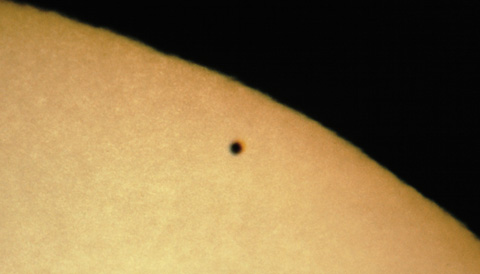
Fred Espenak
Although Venus won't give another performance until 2117, a bit long to wait, Mercury will oblige us much sooner. On May 9, 2016, Mercury will pass in front of the Sun. The last time Mercury marched across that fiery field was in 2006, so this is far from a frequent event. Since a telescope and solar filter are required to view it, the 2016 transit of Mercury will happen, as have so many, unseen by most of Earth's inhabitants. But at least light pollution is not a factor.
Mercury: A Tiny Dot on the Sun
You might say that you could just watch it on the Internet, but I challenge you to chase the real thing. Go outside and see it with your own eyes. For a newcomer to astronomy, finding Mercury at night can be a challenge, but looking for it in front of the Sun narrows down your search area dramatically.
The Sun, though very bright, covers an incredibly small part of the sky. If you make a circle with thumb and forefinger and hold it out at arm's length, the size of the circle that just surrounds the Sun is the size of a pea. You can try this safely at night with the full Moon, since the Sun and the Moon have the same apparent size in the sky. Most people guess that the Moon might be the size of a Ping-Pong ball, but it is much, much smaller.
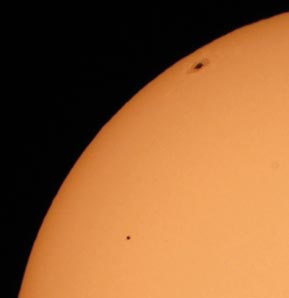
Fred Espenak
So, you won't have any trouble figuring out where to look, but what other problems might arise? You might have seen sunspots on the Sun's surface and some of them are small and fairly round, so is there any way you might mistake one of those for Mercury?
Not a chance. With a transit of Mercury there's no doubt about what you're seeing, since the profile of the planet is a very dark and absolutely circular spot. And it moves across the Sun in a time span of hours, not days, as a sunspot would. You look, and when you look again just minutes later, the planet has moved on to a new location.
When you watch the event in real time, you experience it in a different way. Marvel at how small Mercury is and how fast it moves. Right before your eyes, the innermost planet marches fiercely across the Sun, revealing the true scale of the solar system. Tiny Mercury is dwarfed by our average star. It's just a speck moving across the solar disk. You wonder how it survives.
If Earth were placed in Mercury's orbit, it would only look about 2½ times bigger than Mercury. Our home planet is pretty insignificant on the scale of the solar system, too.
Since the invention of the telescope some 400 years ago, there have only been 55 such transits, and only about two-thirds of them would have been visible from the United States. Why are they so rare? Why don't we see a transit every time Mercury speeds between Earth and the Sun?
The main reason is the inclination of the planets' orbits with respect to one another. If Mercury and Earth revolved around the Sun in the same plane, a transit would occur every time Mercury zipped past Earth, but Mercury's orbit is tilted 7° relative to Earth's. During most of its inferior conjunctions, Mercury passes above or below the Sun from Earth's viewpoint and no transit is seen.
In order for a transit to occur, Mercury must pass Earth within a few hours of the time that it crosses the plane of Earth's orbit. This only happens in early May or early November and only about a dozen times every hundred years.
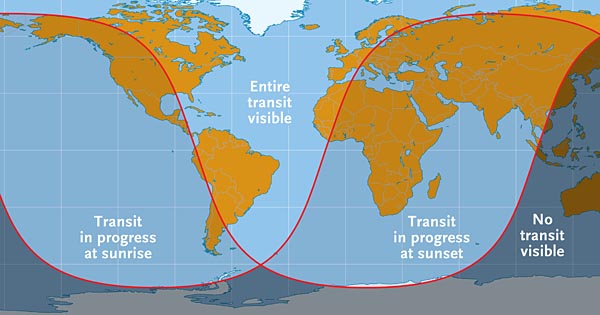
Sky & Telescope diagram / source: Fred Espenak
How to Prepare for Mercury's Transit
I hope by now I've convinced you to look for the transit in 2016, but how should you prepare? If you have a telescope — even a small 60-mm refractor — and a full-aperture solar filter for it, you can start today. But first be sure to review this article on how to observe the Sun safely.
Searching for sunspots on any sunny day is good practice for aiming and focusing your telescope. The Sun is currently near the high-activity part of its 11-year sunspot cycle, so you should be able to find a sunspot or two. The Sun can be fickle in this regard, so you might have to look on several days. Big outbreaks sometimes make the news, which could alert you to a good time to search. Remember, you must have a full-aperture solar filter that goes on the large end of the telescope — not at the eyepiece!
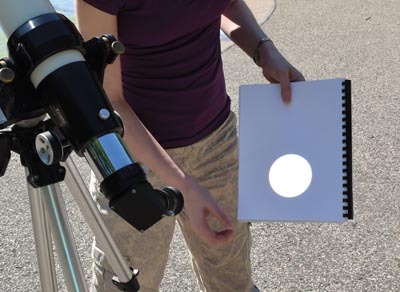
S&T: Sean Walker
Starting now will also afford practice with the projection technique, if you decide to use that method. For a large group, the projection method allows many people to view at once. With your telescope on a tripod, simply position a large piece of white cardboard a foot or two away from the eyepiece. Then move the cardboard back and forth until the image is a convenient size and focus using the eyepiece. Having a stand for the cardboard will make viewing more convenient.
It isn't often you can detect planetary motion in a matter of minutes, but with a transit you can. Ingress and egress along the edge of the Sun make this easiest, of course, but if a sunspot or two happen to grace us with their presence on transit day, then watching Mercury glide past these magnetic storms can be quite captivating.
Transit Day: Monday, May 9th
Since the transit lasts several hours, there will be plenty of time to watch and share the experience with others. Plan a transit party and you might be surprised at how fast those hours fly by. The table below gives important transit times for time zones across the U.S. Depending on your location, the transit may be in progress when the Sun rises. Check your daily newspaper and find the time of sunrise and compare it to the transit times above. You can also find the time of sunrise for your location here.
| Key Times for May 9th's Transit of Mercury | |||
| Time Zone | Transit Begins | Transit Midpoint | Transit Ends |
| Universal (GMT) | 11:12 | 14:57 | 18:42 |
| Eastern (EDT) | 7:12 a.m. | 10:57 a.m. | 2:42 p.m. |
| Central (CDT) | 6:12 a.m. | 9:57 a.m. | 1:42 p.m. |
| Mountain (MDT) | 5:12 a.m. | 8:57 a.m. | 12:42 p.m. |
| Pacific (PDT) | * | 7:57 a.m. | 11:42 a.m. |
| Alaskan (AKDT) | * | 6:57 a.m. | 10:42 a.m. |
| Hawaiian (HST) | * | * | 8:42 a.m. |
* Transit begins before sunrise. Source: Fred Espenak / eclipsewise.com
For observers in western North America, the transit will already be in progress when the Sun rises. To see the entire event, you must be east of a line that passes roughly from eastern South Dakota through eastern Louisiana.
If you are in eastern North America, where the entire transit is visible, what should you look for at the time the transit begins? It will require some concentration, but with luck you can detect Mercury before its disk has moved completely onto the Sun. Scan back and forth along the eastern edge of the Sun, because that is where tiny Mercury will first appear.
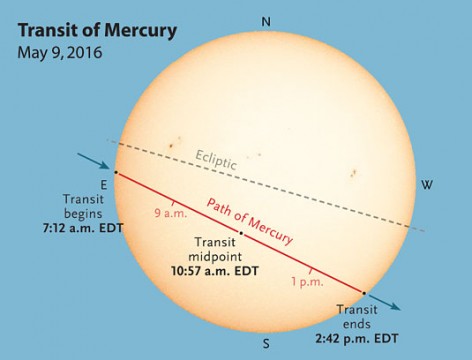
Sky & Telescope diagram
With star diagonals, mirrors, and inverted images, it can be hard to know which way is east or west when looking through your telescope, so use this simple trick: Watch through the eyepiece and see which way the Sun drifts. If you have a clock drive, turn it off for a few seconds and watch for drift. The direction of drift is west.
At the appointed time (around 11:12 UT; 7:12 a.m. EDT), a tiny notch will appear and grow as Mercury slowly creeps onto the Sun. It takes nearly two minutes for the planet to travel its own diameter, so watch carefully to detect that motion. If there are any sunspots present, you'll be surprised at how much darker Mercury's tiny disk will appear in comparison.
As you watch this leisurely celestial ballet, revel in the rareness of the event and think of astronomers in days of yore who had to travel halfway around the world to witness such a sight, or might even have been oblivious to its occurrence.
And what if it's cloudy on May 9th? Well, then, go ahead and search the web using Google and "Mercury transit 2016 live webcast." (One dependable source is Gianluca Masi's Virtual Telescope Project, which will offer live coverage of the transit beginning at 11:00 UT.) But let's hope you have a clear sky and don't have to resort to that.
As the transit nears its end, don't miss the opportunity to watch Mercury slip off the solar disk beginning around 18:38 UT (2:38 p.m. EDT) and taking about 3 minutes.
Next Transit of Mercury: 2019
After viewing my first transit of Mercury in 1999, I asked the proverbial question that springs to an astronomer's lips after the observation of each milestone: "When's the next one?"
In this case, we're in luck because the next transit of Mercury visible in the U.S. is in 2019. After that, there are transits in 2032 and 2039, but those won't be visible from North America. After 2019, observers in the U.S. will have to wait until 2049 for another chance.
On a side note though, if you're going to sign up for that trip to Mars, there's a transit of Venus visible from that planet in 2030. You could even see a transit of Earth in 2084!
But if you're going to remain on planet Earth, the transit pickings are pretty slim for the next 30 years, so don't miss this one. You probably won't have to travel far to view this transit of Mercury, and perhaps it will whet your appetite to chase other astronomical events around the planet. At the very least, it might make you more aware of all those starry dancers silently swirling overhead.
Hold fleet-footed Mercury in your hands: Find Sky & Telescope's detailed and accurately labeled Mercury globe in our online store.
Patricia Totten Espenak, a retired chemistry teacher and amateur astronomer, has experienced 16 total solar eclipses on all seven continents as well as the transits of Venus in 2004 and 2012 and transits of Mercury in 1999 and 2006.
 2
2
Comments
Anthony Barreiro
April 18, 2016 at 3:30 pm
This is a great guide, thank you. I'm taking Monday May 9 off work to observe the transit. I decided not to travel, so I'll only see the last two-thirds of the transit.
I've had an easier time getting oriented to both the Sun and the Moon since I figured out that the northern edge is usually *not* at the top of the Sun or Moon as observed in the sky. North *is* at the top of the Sun at (true, local) noon, and at the top of the Moon when the Moon is crossing the meridian. At other times it helps to think about where the north star is in the sky, and draw a line from the north star to the Sun or the Moon. Where that line first touches the Sun or Moon is the northern point.
You must be logged in to post a comment.
April 22, 2016 at 4:37 pm
Hello,
Do not forget your international readers: do not forget to give the Universal Time of the transit events.
Pierre Brunet
France
You must be logged in to post a comment.
You must be logged in to post a comment.